trichostrongyle herbivores Exam 2 (L13-15)
1/99
There's no tags or description
Looks like no tags are added yet.
Name | Mastery | Learn | Test | Matching | Spaced |
|---|
No study sessions yet.
100 Terms
Which family of nematodes has the most important causes of production and economic loss in livestock
trichostrongyle nematode
Why are trichostrongyle nematodes of ruminants the most important causes of production and economic loss in livestock (general question)
lamb, calf deaths
poor growth rate
tx and management cost
Where does conversion of trichostrongyle egg to L3 occur
Only occurs in pasture where animals are actively grazing
In transmission of ruminant trichostrongyle, what are two ways that they do not transmit dz in relation to environment
do not transmit in confined situations (→ no transmission of ruminant trichostrongyle parasites)
not transmitted to young ruminants bc they are nursing
At what age, must you start being concerned about host and management system in beef calves and sheep/goats
in beef calves around 3-4 months of age
in sheep/goats around 2-3 months of age
In sheep/goats, what 3 GI trichostrongyle nematodes genera cause dz syndrome of ruminants
Haemonchus spp.
Teladorsagia spp.
Trichostrongylus spp.
In cattle, what 3 GI trichostrongyle nematodes genera cause dz syndrome of ruminants
Haemonchus spp.
Ostertagia spp.
Cooperia spp.
Which larvae stage is the infective stage of trichostrongyle nematodes life cycle
L3 larvae
Which gastrointestinal trichostrongyle nematodes has specific seasonal patterns
H. Teladorsagia and H. Trichostrongylus
What occurs with immune response between Teladorsagia and Trichostrongylus
abomasum immune response to Teladorsagia affects proximal SI environment → establishment of Trichostrongylus in autumn
What are the hallmark dz of GI trichostrongyle nematodes
anorexia with diarrhea
What are CS of GI trichostrongyle nematodes (besides the hallmark CS)
anorexia w diarrhea (hallmark)
submandibular edema - bottle jaw
hyporproteinemia
dec well-being
immune suppression
What type dx will GI trichostrongyle nematodes not show up (and why)
necrospy bc works are too small
What are the three methods of measuring FEC in GI trichostrongyle nematodes
McMaster
mini-FLOTAC
modified Wisconsin
What are the dx characteristics of using McMaster in measuring FEC in GI trichostrongyle nematodes
quickest, easiest method
method of choice for sheeps/goats; not sensitive enough for efficacy in cattle
egg detection sensitivity usually 25 or 50 EPG
What are the dx characteristics of using mini-floatac in measuring FEC in GI trichostrongyle nematodes
best method - highest accuracy and precision
recommended method for cattle
egg detection sensitivity is 5 EPG
What are the dx characteristics of using Modified Wisconsin in measuring FEC in GI trichostrongyle nematodes
most time consuming method
least accurat and precise
not recc
In dx of GI trichostrongyle nematodes, what method is most prefered for measuring FEC in cattle
Mini-floatac
In dx of GI trichostrongyle nematodes, what method is most prefered for measuring FEC in sheep/goat
McMaster
For administrating trichostrongyle nematode treatment, sheeps and goats should receive what type of administration method
oral only
For administrating trichostrongyle nematode treatment, cattle should receive what type of administration method
injectables (rather than pour-ons or oral ML)
In sheep and goats, what drug has the least resistance prevalence in Eastern US for trichostrongyle nematodes
levamisole
What are preventative methods if anthelmintics are ineffective in trichostrongyle nematodes
sustainable integrated parasite management “sIPM”
improved pasture management
refugia management
“smart drenching”
novel non-chemical integrated approaches
biological control
What species is most affected by the Haemonchus spp., the predilection site, and common name
most important worm of sheep/goats in USA
abomasum is predilection site
barber pole worm
What is the egg morphology of Heamonchus spp.
dark brown blastomeres in egg
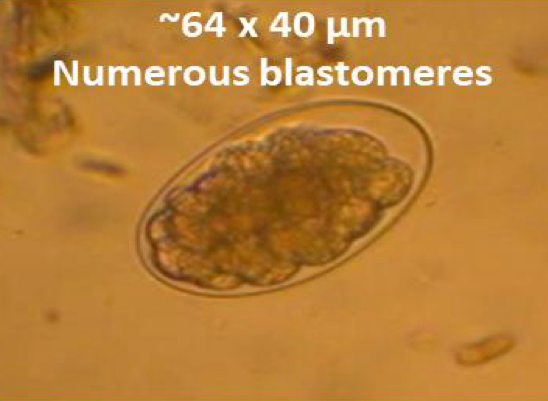
What is the most important parasite of sheep/goats in warm climates
Haemonchus contortus
What species of Haemonchus infects cattle (and what regions does infection occur)
H. placei in subtropics and tropics
What is the PPP of Heamonchus
3-4 weeks
Why is the Heamonhcus spp. referred to as barber pole worm
blood-filled gut of females worms can spiral around their uterus giving a barber pole appearance
When does Haemonchus spp. develop from egg to L3 fastest
egg to L3 is faster in late summer as temp inc
When does egg to L3 stop seasonally in Haemonchus spp.
egg to L3 stops in autumn
What is the expected environment that you would find Haemonchus spp
tropics OR warm, moist environments
cooler climates during summer
What occurs with Haemonchus spp. (and lifestage) to survive during too cold or too dry periods
L4 enter hypoitoic (arrested) state in host GI mucosa
What are common clinical features of Haemonchus spp. in sheep/goats vs Cattle
sheep/goat: Haemonchosis - high blood loss
cattle: clinical dz uncommon
What are CS of Haemonchus spp
anemia
submandibular edema - bottle jaw
black tarry feces
death
What CS would not be present in Haemonchus spp. which otherwise would be common in most GI trichostrongylus nematodes
no diarrhea
Amongst herd of cattle that are infected with Haemonchus spp. what does it mean when many animals appear normal while others are dying
an overdispersion of Haemonchus parasites
In severe cases of Haemonchosis, what would be the two CS
massive blood loss (untreated will lead to death bc of anemia; needs blood transfusion)
FEC are very high
During clinical exam, what are the dx of haemonchosis
using FAMACHA card for anemia
FEC supports dx
Which species of Haemonchosis is less resistant to anthelmintics
H. placei < H. contortus
What is the tx plan for Haemonchosis
combination 2 or 3 anthelmentic drugs
MUST test using FERCT
before and 2 weeks after tx
What is the most important parasite of adult cattle in USA
Ostertagia ostertagia (brown stomach worm)
What is the preferred environment for Ostertagia osteragia and predilection site
cool, wet climates
predilection site: abomasum
What is the egg characteristics of Ostertagia ostertagia
egg have dark brown numerous blastomeres 80-40micrometers (indistinguishable to Haemonchus)
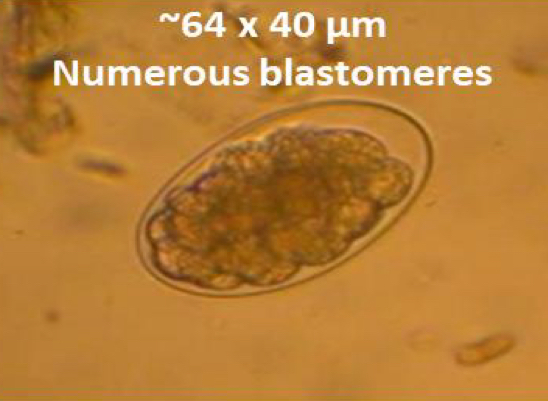
What is the PPP of Ostertagia ostertagia
2 wks
What are the seasonal transmission characteristics of Ostertagia in warm temperate climates
highest transmission in winter-spring
larvae acquired in late spring become hypobiotic (arrested)
(to survive hot summers)
What are the seasonal transmission characteristics of Ostertagia in cool temperate climates
highest transmission in summer-fall
larvae acquired in late fall become hypobiotic
to survive too cold winter in host
What are the difference in grazing patterns of cattle in warm temperate climates vs cool temperate climates; and how does Ostertagia arrest depending on the climate
warm temperate climates - freq grazing all-year; L4 stage arrest over summer
cool temperate climates - seasonal grazing; L4 arrest over winter
What life stage does ostertagia arrest (hypobiosis) and why
early L4 stage arrest for 3-4 mo to avoid adverse environmental conditions
In warm temperate, the L4 stage of Ostertagia will arrest when
over the summertime in the host
In cool temperate, the L4 stage of Ostertagia will arrest when
over wintertime in host
What is the difference between clinical type I disease vs clinical type II disease of Ostertagia ostertagia
Clinical type I - ingested of large number of L3 stages in summer
Clinical type 2 - L4 develops and emerges as adult in late winter causing type 2 dz
In summer ostertagiosis, what is the primary lifecycle of Ostertagia ostertagia to develop clinical type I disease
as temp inc in summer, pasture larval contamination inc reaching infective L3 stage
In winter ostertagiosis, what is the primary lifecycle of Ostertagia ostertagia to develop clinical type II disease
as temp dec in winter, L3 becomes arrested at early L4 stage in abomasal mucosal glands
What is the primary pathology of ostertagia ostertagia
disruption of abomasal mucosa by development of larvae leading to gastric gland destruction
What is the post-mortem pathology of ostertagia ostertagia
abomasum has putrid smell bc of bacterial overgrowth, high pH
abomasum mucosa has nodules
abomasum mucosa edematous and hyperemic
What are the Ostertagia clinical feature involving abomasal gastric glands
larvae develop disrupting abomasal gastric glands
high pH in abomasum due to replacement of HCL-secreting cells
What is the clinical feature of Ostertagia infection relating to pepsin
pepsin inhibits digestion of protein
What is the clinical feature of Ostertagia relating to albumin
albumin leakage thru abomasal mucosa
What is the tx of Ostertagiosis
ML is drug of choice
What species is infected by Teladorasagia circumincinta (and its predilection site)
sheeps/goats in abomasum
What is the egg characteristics of teladorsagia circumcinta
reddish-brwon w numerous blastomeres (~80-40micrometers)
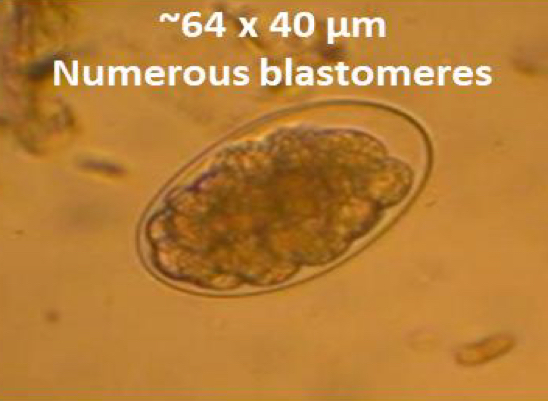
What is the PPP of Teladorsagia circumcinta
2 wks
What causes loss of weight and appetite in Teladorsagosis dz (caused by T. circumcinta infection)
hyperplastic inflammation of abomasal mucosa (abomasitis)
What causes hypoprotinaemia in Teladorsagosis dz (caused by T. circumcinta infection)
leakage across damaged mucosa
What causes loss of weight and appetite WITH watery diarrhea in Teladorsagosis dz (caused by T. circumcinta infection)
impaired abomasal func associated w alteration in pH
What is the appearance of abomsal mucosa of Teladorsagia infection
morocco leather apperance
What is the tx of teladorsagosis
Benzimidazole + ivermectin DOC
What are the six sustainable control programs of teladorsagosis
build up infection in host
farming system
seasonal appearance
pasture contamination
TST and refugia management
dx tests
What is the host and predilection site of trichostrongylus axei
hosts: cattle, small ruminants, horses, pigs
predilection site:
abomasum - ruminants
stomach - horses pig
What is the smallest trichostrongyle
T. axei
What trichostrongyle nematode has unique characteristic of cross-infection in mixed species grazing situation
Trichostrongylus axei
Trichostrongylus axei is not usually a _____ pathogen by itself and is part of the ruminant ____ complex
primary; PGE
What species does Nematodirus battus infect
sheep/goats
What species does Nematodirus helvetianus infect
cattle
What species does Nematodirus spathiger infect
cattle, sheep/goat
What is different in the life cycle and epidemiology of Nematodirus spp. compared to typical trichostrongyle life cycle
L3 develops w/in egg and then egg hatches
What is the largest SI trichostrongyle
Nematodirus spp.
What is the typical appearance of Nematodirus spp. (part of the SI trichostrongylus family)
males have long, thin pronounced spicules
white worms coiled around villi
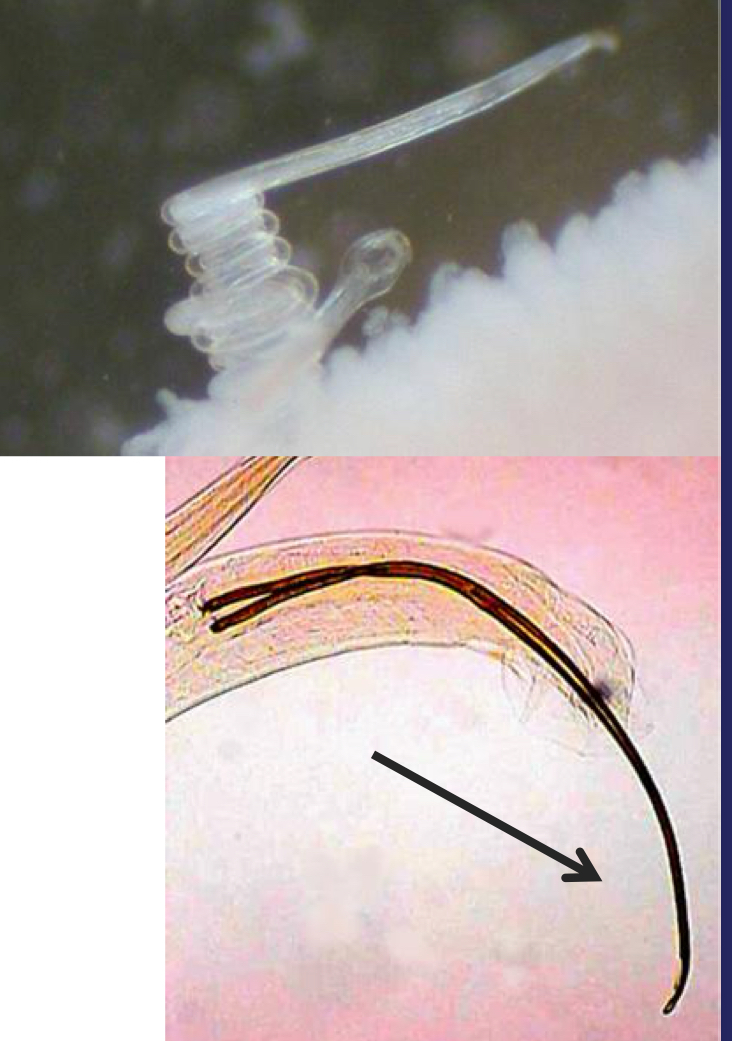
What are the seasonal weather requirements for Nematodirus spp. to hatch
hatching of eggs requires a prolonged chill winter followed by hatching normally in spring
Which SI Trichostrongyle is considered a lamb-to-lamb dz
Nematodirus spp.
What are the temperature requirements for hatching releasing of L3 Nematodirus spp.
a cold exposure followed by daily temp above 10degrees Celsius
In Nematodirus battus, pathology can be severe due to the occurrence of _____ _________
heavy infection
What are the clinical features of Nematodirus spp.
cotton wool-like bundle on intestinal mucosa
acute onset diarrhea
sudden death
lethargy
weight loss
dehydration
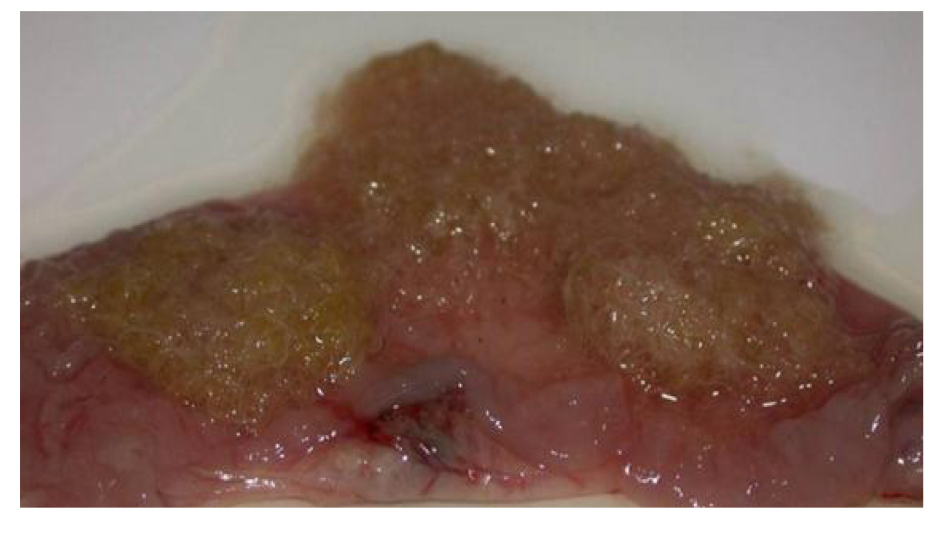
What is the predilection site of Nematodirus spp.
SI mucosa
The SI Trichostrongylus — T. colubriformis & T. vitrinus — infects what spp.
ruminants and cattle (less important in cattle); the most important nematode in sheeps/goats
What are the typical CS of T. colubriformis & T. vitrinus
diarrhea + weight loss
Mucosal and villus hypertrophy
protein leakage, electrolyte and mineral imbalance
anorexia w dark scour
What SI Trichostrongylus is a predominant contributor to FEC in young calves
Cooperia spp.
What life stage of cattle are infected by Cooperia spp.
young calves; never a problem in adult cattle
What is the major clinical feature of Cooperia spp. as it relates to production
rarely produces clinical dz but causes significant production loss
In Cooperia spp. tx, what age do you treat calves
4-12 mo
What tx would adult cows need for Cooperia spp.
adults cows will not need tx for cooperia spp.
What is the tx strategy for Cooperia spp.
Benzimidazoles + levamisole
ML — ivermectin — is resisted
pour-ons are worthless
What is the LI strongyle of ruminants and cattle
Oesophagostomum spp.
What are the hosts of Oesophagostomum spp.
cattle
sheep/goats
swine
What is the appearance of Oesophagostomum spp.
stout white worms
shallow buccal cavity
cephalic vesicle
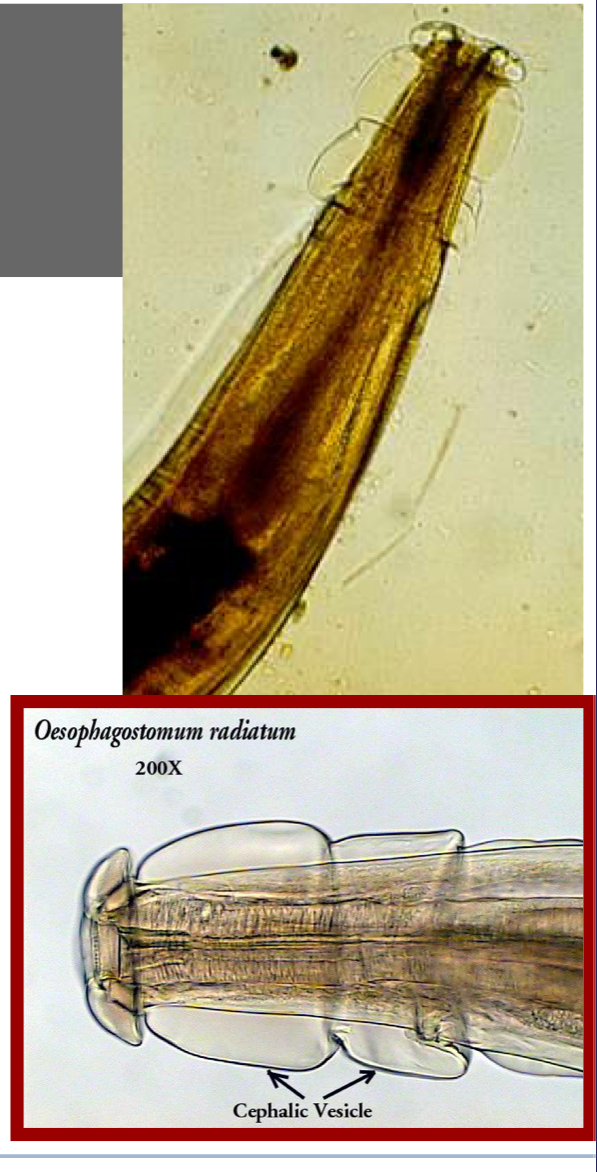
What is the predilection site of Cooperia spp.
SI
What is the predilection site of Oesophagostomum spp.
LI
What is the primary pathology of Oesophagostomum spp.
presence of larvae in nodules stimulating an inflammatory response interfering w intestinal motility and absorption
During post-mortem, what does Oesophagostomum spp. infection look like
pus-filled nodules in LI
stout white worms in LI